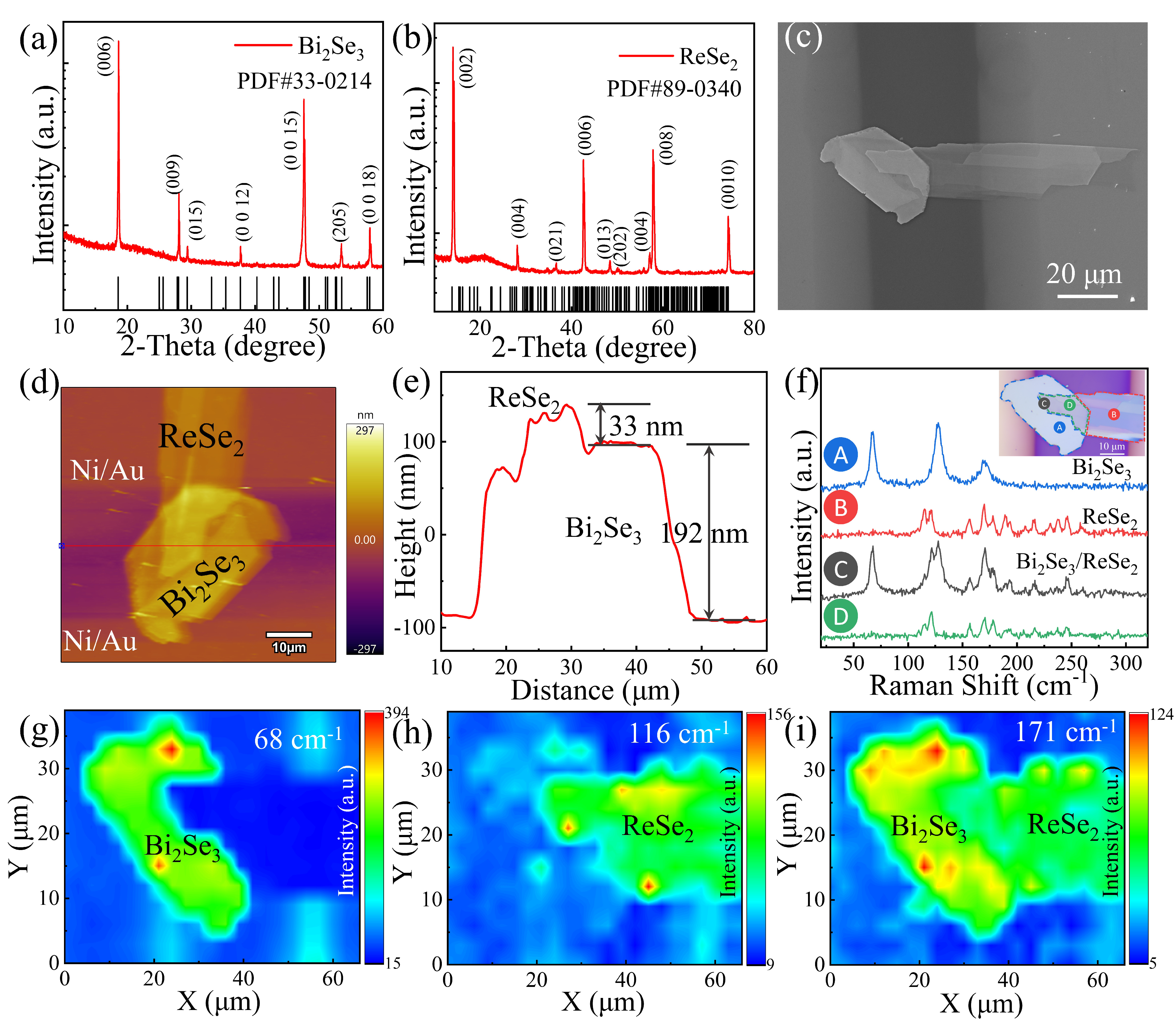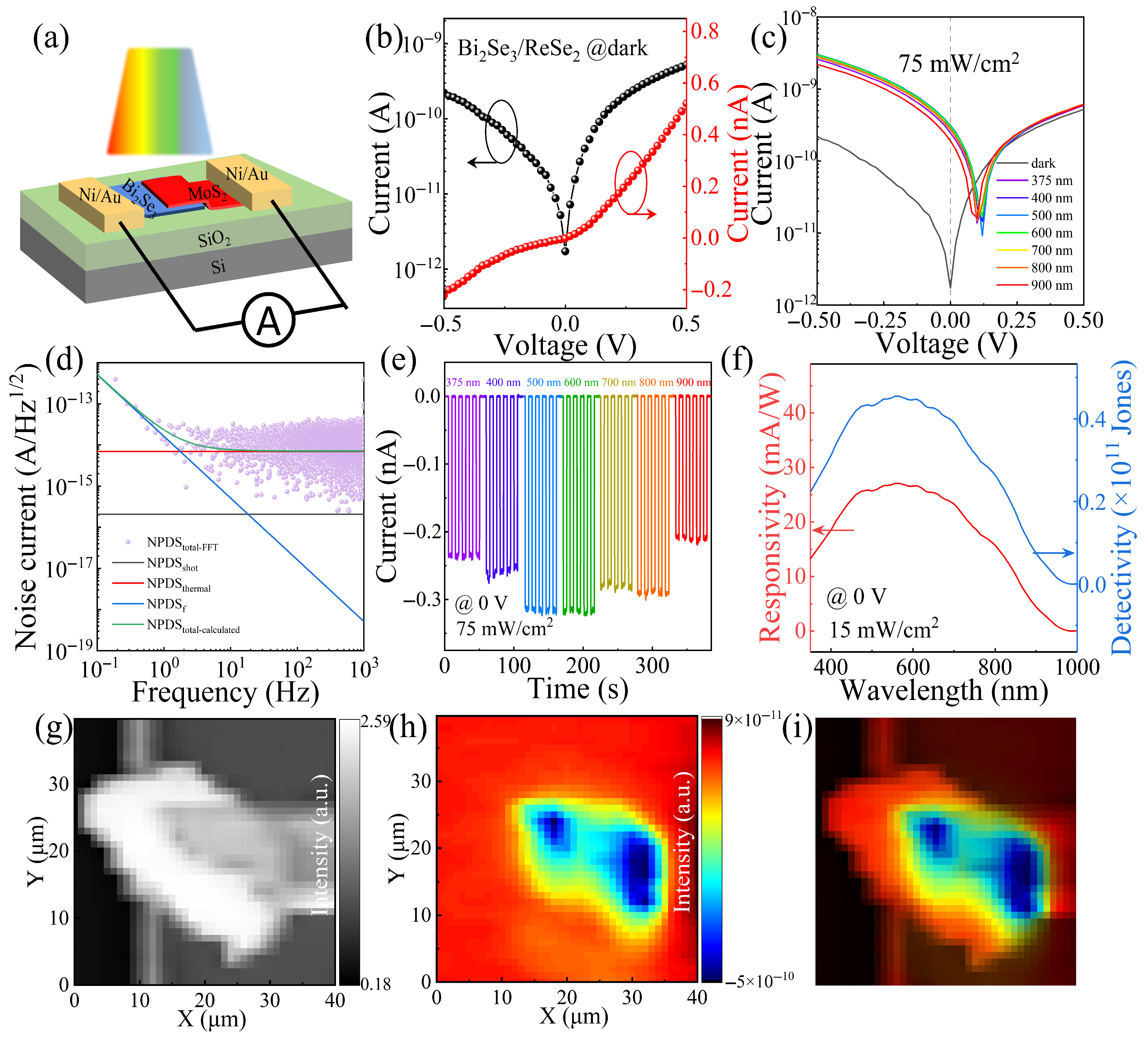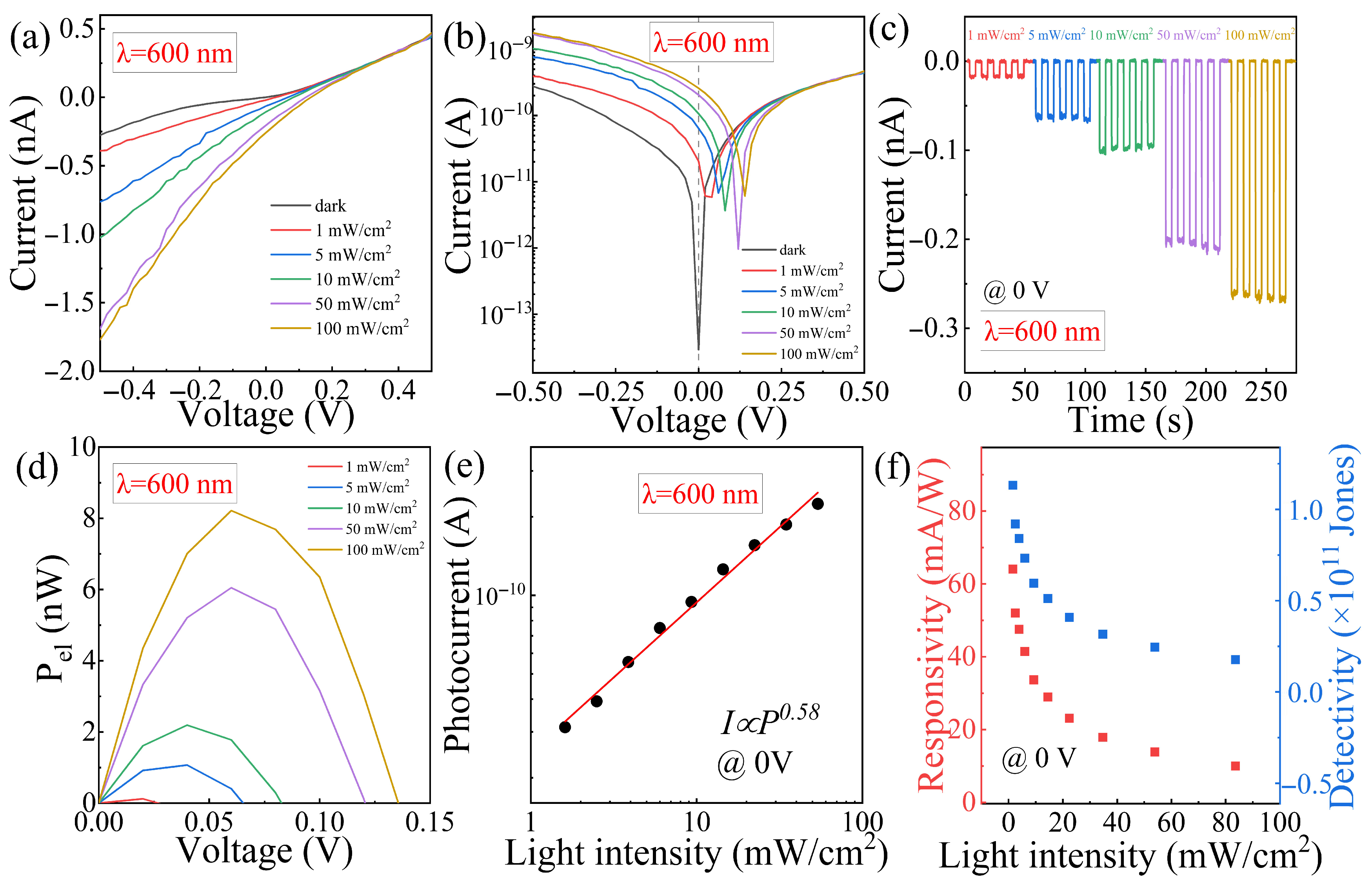High-Performance Self-Powered Broadband Photodetectors Based on a Bi2Se3 Topological Insulator/ReSe2 Heterojunction for Signal Transmission
Abstract
1. Introduction
2. Materials and Methods
2.1. Synthesis of BiSe TIs
2.2. Fabrication of the BiSe/ReSe Heterojunction and the BiSe Field Effect Transistor (FET)
2.3. Characterization and Measurements
3. Results and Discussion
| Photodetector | Self-Powered (0 V Bias) | Wavelength [nm] | Responsivity [mA/W] | Rise Time/Fall Time | Ref. |
|---|---|---|---|---|---|
| BiSe/Si | no | 808 | 6.96 × 10 (5 V) | 19.7 s/35.2 s | [38] |
| BiSe/SnTe | yes | 1550 | 145.74 (0 V) | 6.9 s/19.2 s | [39] |
| BiSe/Si | yes | 808 | 2.43 × 10 (−1 V) | 2.5 s/5.5 s | [40] |
| InSe/ReSe | no | 638 | 1.61 × 10 (2 V) | 360 s/390 s | [41] |
| BiS/MoS | yes | 420 | 0.218 (0 V) | 4 ms/15 ms | [42] |
| BiSe/ReSe | yes | 600 | 64 (0 V) | 345 s/336 s | This work |
4. Conclusions
Supplementary Materials
Author Contributions
Funding
Data Availability Statement
Conflicts of Interest
References
- Xie, Y.; Zhang, B.; Wang, S.; Wang, D.; Wang, A.; Wang, Z.; Yu, H.; Zhang, H.; Chen, Y.; Zhao, M.; et al. Ultrabroadband MoS2 photodetector with spectral response from 445 to 2717 nm. Adv. Mater. 2017, 29, 1605972. [Google Scholar] [CrossRef] [PubMed]
- Shanmugam, V.; Mensah, R.A.; Babu, K.; Gawusu, S.; Chanda, A.; Tu, Y.; Neisiany, R.E.; Försth, M.; Sas, G.; Das, O. A review of the synthesis, properties, and applications of 2D materials. Part. Part. Syst. Charact. 2022, 39, 2200031. [Google Scholar] [CrossRef]
- Long, M.; Wang, P.; Fang, H.; Hu, W. Progress, challenges, and opportunities for 2D material based photodetectors. Adv. Funct. Mater. 2019, 29, 1803807. [Google Scholar] [CrossRef]
- Chen, X.; Rogers, J.A.; Lacour, S.P.; Hu, W.; Kim, D.H. Materials chemistry in flexible electronics. Chem. Soc. Rev. 2019, 48, 1431–1433. [Google Scholar] [CrossRef] [PubMed]
- Pang, Y.; Yang, Z.; Yang, Y.; Ren, T.L. Wearable electronics based on 2D materials for human physiological information detection. Small 2020, 16, 1901124. [Google Scholar] [CrossRef]
- Island, J.O.; Steele, G.A.; van der Zant, H.S.; Castellanos-Gomez, A. Environmental instability of few-layer black phosphorus. 2D Mater. 2015, 2, 011002. [Google Scholar] [CrossRef]
- Shen, X.; Lin, X.; Peng, Y.; Zhang, Y.; Long, F.; Han, Q.; Wang, Y.; Han, L. Two-dimensional materials for highly efficient and stable perovskite solar cells. Nano-Micro Lett. 2024, 16, 201. [Google Scholar] [CrossRef]
- Dziobek-Garrett, R.; Imperiale, C.J.; Wilson, M.W.; Kempa, T.J. Photon upconversion in a vapor deposited 2D inorganic–organic semiconductor heterostructure. Nano Lett. 2023, 23, 4837–4843. [Google Scholar] [CrossRef]
- Qi, X.L.; Zhang, S.C. Topological insulators and superconductors. Rev. Mod. Phys. 2011, 83, 1057–1110. [Google Scholar] [CrossRef]
- Zhang, H.; Liu, C.X.; Qi, X.L.; Dai, X.; Fang, Z.; Zhang, S.C. Topological insulators in Bi2Se3, Bi2Te3 and Sb2Te3 with a single Dirac cone on the surface. Nat. Phys. 2009, 5, 438–442. [Google Scholar] [CrossRef]
- Steinberg, H.; Gardner, D.R.; Lee, Y.S.; Jarillo-Herrero, P. Surface state transport and ambipolar electric field effect in Bi2Se3 nanodevices. Nano Lett. 2010, 10, 5032–5036. [Google Scholar] [CrossRef] [PubMed]
- Sun, J.; Singh, D.J. Using gapped topological surface states of Bi2Se3 films in a field effect transistor. J. Appl. Phys. 2017, 121, 064301. [Google Scholar] [CrossRef]
- Yan, Y.; Wang, L.X.; Yu, D.P.; Liao, Z.M. Large magnetoresistance in high mobility topological insulator Bi2Se3. Appl. Phys. Lett. 2013, 103, 033106. [Google Scholar] [CrossRef]
- Das, S.K.; Sahoo, U.P.; Das, B.; Ghorai, G.; Samal, P.; Sahoo, P.K. Defect induced unconventional ferromagnetism in Au intercalated Bi2Se3 nanocrystals for spintronic applications. Adv. Quantum Technol. 2023, 6, 2300169. [Google Scholar] [CrossRef]
- Li, J.; Chang, K. Electric field driven quantum phase transition between band insulator and topological insulator. Appl. Phys. Lett. 2009, 95, 222110. [Google Scholar] [CrossRef]
- Besbas, J.; Banerjee, K.; Son, J.; Wang, Y.; Wu, Y.; Brahlek, M.; Koirala, N.; Moon, J.; Oh, S.; Yang, H. Helicity-dependent photovoltaic effect in Bi2Se3 under normal incident light. Adv. Opt. Mater. 2016, 4, 1642–1650. [Google Scholar] [CrossRef]
- Li, Y.; Wang, S.; Hong, J.; Zhang, N.; Wei, X.; Zhu, T.; Zhang, Y.; Xu, Z.; Liu, K.; Jiang, M.; et al. Polarization-sensitive photodetector based on high crystallinity Quasi-1D BiSeI nanowires synthesized via chemical vapor deposition. Small 2023, 19, 2302623. [Google Scholar] [CrossRef]
- Linghu, C.; Zhang, S.; Wang, C.; Song, J. Transfer printing techniques for flexible and stretchable inorganic electronics. NPJ Flex. Electron. 2018, 2, 26. [Google Scholar] [CrossRef]
- Du, K.; Wathuthanthri, I.; Liu, Y.; Xu, W.; Choi, C.H. Wafer-scale pattern transfer of metal nanostructures on polydimethylsiloxane (PDMS) substrates via holographic nanopatterns. ACS Appl. Mater. Interfaces 2012, 4, 5505–5514. [Google Scholar] [CrossRef]
- Ermolaev, G.A.; Vyslanko, I.S.; Tselin, A.P.; El-Sayed, M.A.; Tatmyshevskiy, M.K.; Slavich, A.S.; Yakubovsky, D.I.; Mironov, M.S.; Mazitov, A.B.; Eghbali, A.; et al. Broadband optical properties of Bi2Se3. Nanomaterials 2023, 13, 1460. [Google Scholar] [CrossRef]
- Atuchin, V.; Golyashov, V.; Kokh, K.; Korolkov, I.; Kozhukhov, A.; Kruchinin, V.; Makarenko, S.; Pokrovsky, L.; Prosvirin, I.; Romanyuk, K.; et al. Formation of inert Bi2Se3 (0001) cleaved surface. Cryst. Growth Des. 2011, 11, 5507–5514. [Google Scholar] [CrossRef]
- Wang, F.; Luo, P.; Zhang, Y.; Huang, Y.; Zhang, Q.; Li, Y.; Zhai, T. Band structure engineered tunneling heterostructures for high-performance visible and near-infrared photodetection. Sci. China Mater. 2020, 63, 1537–1547. [Google Scholar] [CrossRef]
- Ma, J.; Chen, S.; Zhao, L.; Chen, J.; Lan, Z.; Yang, M.; Sun, Y.; Zheng, Z.; Gao, W.; Li, J. 2D double heterostructure infrared photodetector with Type-III band alignment by incorporating Bi2Se3 Layer. Adv. Opt. Mater. 2024, 12, 2302563. [Google Scholar] [CrossRef]
- Wolverson, D.; Crampin, S.; Kazemi, A.S.; Ilie, A.; Bending, S.J. Raman spectra of monolayer, few-layer, and bulk ReSe2: An anisotropic layered semiconductor. ACS Nano 2014, 8, 11154–11164. [Google Scholar] [CrossRef]
- Pradhan, N.R.; Garcia, C.; Isenberg, B.; Rhodes, D.; Feng, S.; Memaran, S.; Xin, Y.; McCreary, A.; Walker, A.R.H.; Raeliarijaona, A.; et al. Phase modulators based on high mobility ambipolar ReSe2 field-effect transistors. Sci. Rep. 2018, 8, 12745. [Google Scholar] [CrossRef]
- Jahromi, H.D.; Lotfiani, A. A fast and sensitive Schottky photodiode with surface plasmon enhanced photocurrent and extremely low dark current for high-frequency applications in near-infrared. IEEE Sens. J. 2022, 22, 20430–20437. [Google Scholar] [CrossRef]
- Jahromi, H.D.; Mahmoodi, A.; Sheikhi, M.H.; Zarifkar, A. Spectral response, dark current, and noise analyses in resonant tunneling quantum dot infrared photodetectors. Appl. Opt. 2016, 55, 8494–8499. [Google Scholar] [CrossRef]
- Chen, S.; Fu, Y.; Ishaq, M.; Li, C.; Ren, D.; Su, Z.; Qiao, X.; Fan, P.; Liang, G.; Tang, J. Carrier recombination suppression and transport enhancement enable high-performance self-powered broadband Sb2Se3 photodetectors. InfoMat 2023, 5, e12400. [Google Scholar] [CrossRef]
- Mihaila, M.; Varasteanu, P. Surface phonons in the 1/f noise of Bi2Se3. Appl. Phys. Lett. 2025, 126, 032202. [Google Scholar] [CrossRef]
- Bhattacharyya, S.; Banerjee, M.; Nhalil, H.; Islam, S.; Dasgupta, C.; Elizabeth, S.; Ghosh, A. Bulk-induced 1/f noise at the surface of three-dimensional topological insulators. ACS Nano 2015, 9, 12529–12536. [Google Scholar] [CrossRef]
- Mahmoodi, A.; Jahromi, H.D.; Sheikhi, M.H. Dark current modeling and noise analysis in quantum dot infrared photodetectors. IEEE Sens. J. 2015, 15, 5504–5509. [Google Scholar] [CrossRef]
- Zheng, D.; Fang, H.; Wang, P.; Luo, W.; Gong, F.; Ho, J.C.; Chen, X.; Lu, W.; Liao, L.; Wang, J.; et al. High-performance ferroelectric polymer side-gated CdS nanowire ultraviolet photodetectors. Adv. Funct. Mater. 2016, 26, 7690–7696. [Google Scholar] [CrossRef]
- Kalimuddin, S.; Das, B.; Chatterjee, S.; Bera, A.; Bera, S.; Chattopadhyay, K.; Mondal, M. Low-frequency 1/f noise and barrier height inhomogeneity in topological insulator-based photodetectors. ACS Appl. Mater. Interfaces 2025, 17, 35781–35789. [Google Scholar] [CrossRef] [PubMed]
- Buscema, M.; Groenendijk, D.J.; Blanter, S.I.; Steele, G.A.; Van Der Zant, H.S.; Castellanos-Gomez, A. Fast and broadband photoresponse of few-layer black phosphorus field-effect transistors. Nano Lett. 2014, 14, 3347–3352. [Google Scholar] [CrossRef]
- Shiju, K.; Praveen, T.; Aneesh, J.; Manuvel, J. Organic field effect transistor with conductivity enhanced PEDOT: PSS composite electrodes. AIP Conf. Proc. 2013, 1536, 1139–1140. [Google Scholar]
- Li, W.; Yang, R.; Han, X.; Cheng, L.; Yin, T.; Gao, K.; Gan, X.; Wang, Y.; Wang, S. Bias tunable SnS2/ReSe2 tunneling photodetector with high responsivity and fast response speed. Small 2025, 21, 2408379. [Google Scholar] [CrossRef]
- Yu, M.; Fang, C.; Han, J.; Liu, W.; Gao, S.; Huang, K. Construction of Bi2O2Se/Bi2Se3 van der Waals heterostructures for self-powered and broadband photodetectors. ACS Appl. Mater. Interfaces 2022, 14, 13507–13515. [Google Scholar] [CrossRef]
- Nandi, S.; Ghosh, K.; Meyyappan, M.; Giri, P. 2D MXene electrode-enabled high-performance broadband photodetector based on a CVD-grown 2D Bi2Se3 ultrathin film on Silicon. ACS Appl. Electron. Mater. 2023, 5, 6985–6995. [Google Scholar] [CrossRef]
- Zhang, H.; Song, Z.; Li, D.; Xu, Y.; Li, J.; Bai, C.; Man, B. Near-infrared photodetection based on topological insulator PN heterojunction of SnTe/Bi2Se3. Appl. Surf. Sci. 2020, 509, 145290. [Google Scholar] [CrossRef]
- Zhang, H.; Zhang, X.; Liu, C.; Lee, S.T.; Jie, J. High-responsivity, high-detectivity, ultrafast topological insulator Bi2Se3/silicon heterostructure broadband photodetectors. ACS Nano 2016, 10, 5113–5122. [Google Scholar] [CrossRef]
- Du, C.; Gao, H.; Du, W.; Li, J.; Leng, J.; Li, K.; Wang, W. High responsivity and broadband polarized photodetectors based on InSe/ReSe2 van der Waals heterostructures. J. Alloys Compd. 2022, 919, 165586. [Google Scholar] [CrossRef]
- Hui, J. Two-dimensional Bi2S3/MoS2 van der Waals heterostructure for self-powered photodetectors. Appl. Phys. Express 2023, 16, 015507. [Google Scholar] [CrossRef]
- Wu, C.; Zhao, T.; He, H.; Hu, H.; Liu, Z.; Wang, S.; Zhang, F.; Wang, Q.; Liu, A.; Wu, F.; et al. Enhanced performance of gallium-based wide bandgap oxide semiconductor heterojunction photodetector for solar-blind optical communication via oxygen vacancy electrical activity modulation. Adv. Opt. Mater. 2024, 12, 2302294. [Google Scholar] [CrossRef]






Disclaimer/Publisher’s Note: The statements, opinions and data contained in all publications are solely those of the individual author(s) and contributor(s) and not of MDPI and/or the editor(s). MDPI and/or the editor(s) disclaim responsibility for any injury to people or property resulting from any ideas, methods, instructions or products referred to in the content. |
© 2025 by the authors. Licensee MDPI, Basel, Switzerland. This article is an open access article distributed under the terms and conditions of the Creative Commons Attribution (CC BY) license (https://creativecommons.org/licenses/by/4.0/).
Share and Cite
Wei, Y.; Wan, P.; Li, L.; He, T.; Ma, W.; Xu, T.; Yang, B.; Sha, S.; Kan, C.; Jiang, M. High-Performance Self-Powered Broadband Photodetectors Based on a Bi2Se3 Topological Insulator/ReSe2 Heterojunction for Signal Transmission. Photonics 2025, 12, 709. https://doi.org/10.3390/photonics12070709
Wei Y, Wan P, Li L, He T, Ma W, Xu T, Yang B, Sha S, Kan C, Jiang M. High-Performance Self-Powered Broadband Photodetectors Based on a Bi2Se3 Topological Insulator/ReSe2 Heterojunction for Signal Transmission. Photonics. 2025; 12(7):709. https://doi.org/10.3390/photonics12070709
Chicago/Turabian StyleWei, Yun, Peng Wan, Lijian Li, Tao He, Wanyu Ma, Tong Xu, Bingwang Yang, Shulin Sha, Caixia Kan, and Mingming Jiang. 2025. "High-Performance Self-Powered Broadband Photodetectors Based on a Bi2Se3 Topological Insulator/ReSe2 Heterojunction for Signal Transmission" Photonics 12, no. 7: 709. https://doi.org/10.3390/photonics12070709
APA StyleWei, Y., Wan, P., Li, L., He, T., Ma, W., Xu, T., Yang, B., Sha, S., Kan, C., & Jiang, M. (2025). High-Performance Self-Powered Broadband Photodetectors Based on a Bi2Se3 Topological Insulator/ReSe2 Heterojunction for Signal Transmission. Photonics, 12(7), 709. https://doi.org/10.3390/photonics12070709





